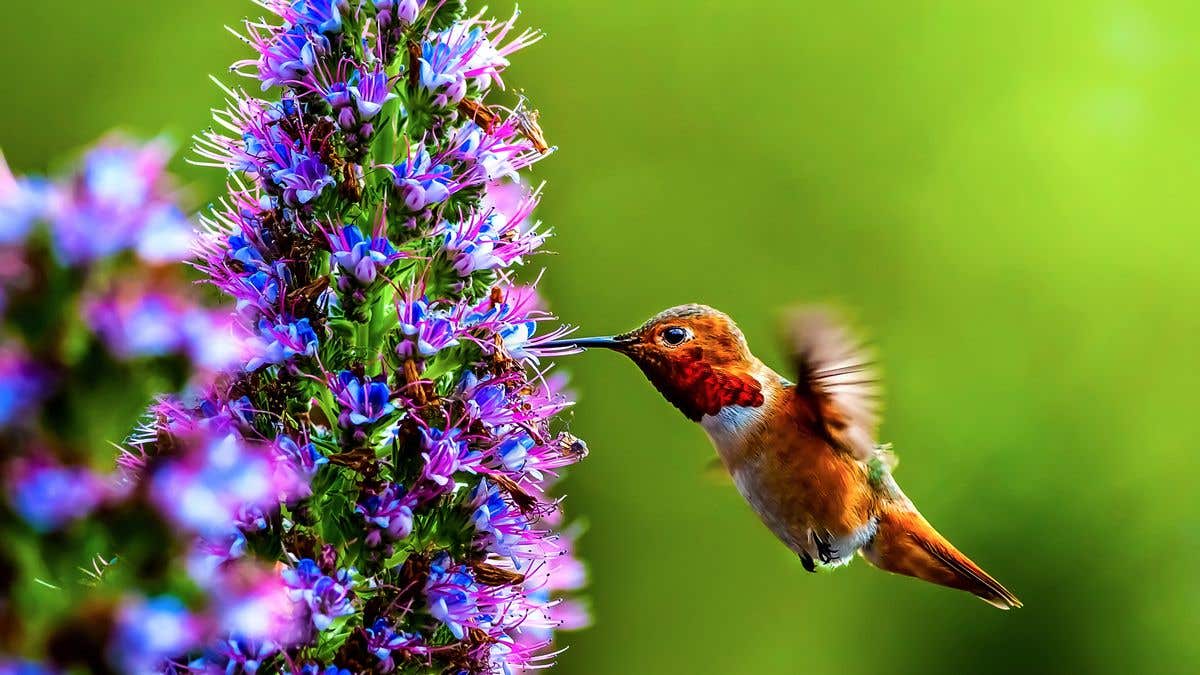Hummingbirds drink alcohol and fairly often, study finds
When you fill up your backyard hummingbird feeder with sugary solution, you likely anticipate a flurry of birds drinking their fill.

[June 25, 2023: Staff Writer, The Brighter Side of News]
With hummingbirds consuming nearly 80% of their body mass daily in nectar, Dudley was intrigued to examine the potential alcohol intake these birds experience. (CREDIT: Creative Commons)
When you fill up your backyard hummingbird feeder with sugary solution, you likely anticipate a flurry of petite, vibrant wings fluttering to take their fill. However, you might be unknowingly initiating a microscopic process of fermentation as yeast take residence in the sweet nectar, setting the stage for natural alcohol production.
This same process occurs in the nectar-laden blooms scattered across landscapes, creating an irresistible pull for the yeast and bacteria thriving on metabolizing sugar into ethanol. This realization sparked a series of inquiries in the mind of Robert Dudley, a biologist at the University of California, Berkeley.
With hummingbirds consuming nearly 80% of their body mass daily in nectar, Dudley was intrigued to examine the potential alcohol intake these birds experience. Given that alcohol is a natural byproduct of the sugar-dense fruit and floral nectar, he began to question if ethanol was an unavoidable component of not only the hummingbird's diet but that of many other animals.
"Hummingbirds are eating 80% of their body mass a day in nectar," remarked Dudley, a UC Berkeley professor of integrative biology. "Most of it is water and the remainder sugar. But even if there are very low concentrations of ethanol, that volumetric consumption would yield a high dosage of ethanol, if it were out there. Maybe, with feeders, we're not only farming hummingbirds, we're providing a seat at the bar every time they come in."
Related Stories:
As the COVID-19 pandemic made it challenging to conduct research in Central America and Africa, where nectar-feeding sunbirds reside, Dudley tapped into his resourceful side. With the aid of several undergraduate students, he carried out an investigation on the hummingbirds frequenting the feeder outside his office window, aiming to determine whether these birds found alcohol-laden sugar water appealing or off-putting. The subjects under the microscope were three male Anna's hummingbirds (Calypte anna), known for their year-round residency in the Bay Area.
The revelations of this study, published in the Royal Society Open Science, exposed a fascinating aspect of hummingbird behavior: they seemed quite content to indulge in sugar water with up to 1% alcohol by volume, finding it just as attractive as its alcohol-free counterpart.
Interestingly, these feathery creatures showed moderate drinking habits, halving their consumption when the sugar water had an alcohol concentration of 2%.
"They're consuming the same total amount of ethanol, they're just reducing the volume of the ingested 2% solution. So that was really interesting," Dudley noted. "That was a kind of a threshold effect and suggested to us that whatever's out there in the real world, it's probably not exceeding 1.5%."
An Anna's Hummingbird sipping from a California Fuchsia. A new study suggests that hummingbirds are accustomed to ingesting small amounts of alcohol from natural sources, such as nectar. It's unclear whether ethanol attracts them, however. (CREDIT:
Víctor M. Ortega Jiménez)
Further tests on the alcohol content in sugar water left in the feeder for two weeks revealed a concentration of about 0.05% by volume.
"Now, 0.05% just doesn't sound like much, and it's not. But again, if you're eating 80% of your body weight a day, at .05% of ethanol you're getting a substantial load of ethanol relative to your body mass," Dudley explained. "So it's all consistent with the idea that there's a natural, chronic exposure to physiologically significant levels of ethanol derived from this nutritional source."
Ethanol concentration of hummingbird feeder solutions through time for a large feeder (blue line), and for two trials with a small feeder (orange and grey lines). (b) Weekly change in ethanol concentration as a function of weekly mean temperature. The linear regression is given by y = 0.007 x −0.08 (adj. R2 = 0.85, p
The hummingbirds' astonishingly swift metabolism seems to prevent them from experiencing intoxication despite the alcohol intake. Dudley clarified, "They burn the alcohol and metabolize it so quickly. Likewise with the sugars. So they're probably not seeing any real effect. They're not getting drunk."
This study is a part of an extensive project by Dudley and his UC Berkeley colleagues — herpetologist Jim McGuire and bird expert Rauri Bowie. As experts in integrative biology and curators at UC Berkeley's Museum of Vertebrate Zoology, they aim to uncover the role alcohol plays in the diets of animals, particularly in tropical regions where easily fermentable fruits and sugary nectar are abundant.
"Does alcohol have any behavioral effect? Does it stimulate feeding at low levels? Does it motivate more frequent attendance of a flower if they get not just sugar, but also ethanol? I don't have the answers to these questions. But that's experimentally tractable," Dudley said, emphasizing the significant potential of his research.
A part of this endeavor, funded by the National Science Foundation, involves testing the alcohol content of fruits in Africa and nectar in flowers in the UC Botanical Garden. Surprisingly, there are no systematic studies of the alcohol content in fruits and nectars, or alcohol consumption by nectar-sipping birds, insects, mammals, or fruit-eating animals, including primates.
However, previous isolated studies hint at intriguing possibilities. For example, a 2008 study discovered that palm flower nectar consumed by pen-tailed tree shrews, small, rat-like creatures in West Malaysia, contained alcohol levels as high as 3.8% by volume. Another 2015 study found similar alcohol levels in the nectar consumed by the slow loris, a primate species, and demonstrated that both slow lorises and aye-ayes, another primate, favored nectar with a higher alcohol content.
Dudley's new study provides the first evidence of birds consuming alcohol produced through natural fermentation.
"This is the first demonstration of ethanol consumption by birds, quote, in the wild. I'll use that phrase cautiously because it's a lab experiment and feeder measurement," Dudley said. "But the linkage with the natural flowers is obvious. This just demonstrates that nectar-feeding birds, not just nectar-feeding mammals, not just fruit-eating animals, are all potentially exposed to ethanol as a natural part of their diet."
The next stage in this exploration will measure the naturally occurring ethanol levels in flowers and quantify how often it's consumed by birds. Dudley plans to extend his research to include Old World sunbirds and honey eaters in Australia, both of which occupy the nectar-consuming ecological niche similar to hummingbirds in America.
Dudley's long-held fascination with alcohol use and misuse, demonstrated in his 2014 book, "The Drunken Monkey, Why we drink and abuse alcohol," posits that human attraction to alcohol is an evolutionary adaptation among primates to enhance survival. However, he argues, the advent of industrial alcohol production has in many cases turned this attraction into abuse.
"Why do humans drink alcohol at all, as opposed to vinegar or any of the other 10 million organic compounds out there? And why do most humans actually metabolize it, burn it, and use it pretty effectively, often in conjunction with food, but then some humans also consume to excess?" he asked.
To better understand human attraction to alcohol, Dudley posits the need for improved animal model systems and an acknowledgment of the substantial natural availability of ethanol. This availability extends beyond primates feeding on fruit and nectar but includes a variety of other birds, mammals, and insects feeding on flowers and fruits. He concluded, "The comparative biology of ethanol consumption may yield insight into modern day patterns of consumption and abuse by humans."
Dudley's research, therefore, offers a window into the intricate symbiotic relationships between nature's micro and macroscopic realms, their potential impact on animal behaviors, and the larger implications for understanding human attraction and response to alcohol.
Note: Materials provided above by The Brighter Side of News. Content may be edited for style and length.
Like these kind of feel good stories? Get the Brighter Side of News' newsletter.



